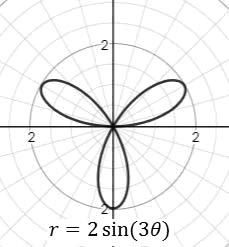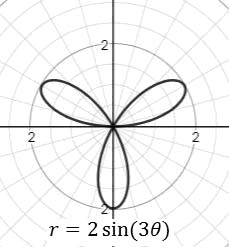Problem 1AYU Problem 2AYU: The difference formula for cosine is cos( AB )= . (p.490) Problem 3AYU Problem 4AYU: Is the sine function even, odd, or neither? (p. 404) Problem 5AYU: sin 5 4 = . (pp. 385-387) Problem 6AYU: cos 2 3 = . (pp. 385-387) Problem 7AYU: An equation whose variables are polar coordinates is called a(n) _____ ________. Problem 8AYU: True or False The tests for symmetry in polar coordinates are always conclusive. Problem 9AYU Problem 10AYU Problem 11AYU: True or False A cardioid passes through the pole. Problem 12AYU: Rose curves are characterized by equations of the form r=acos( n ) or r=asin( n ),a0 . If n0 is... Problem 13AYU: In Problems 15-30, transform each polar equation to an equation in rectangular coordinates. Then... Problem 14AYU: In Problems 15-30, transform each polar equation to an equation in rectangular coordinates. Then... Problem 15AYU: In Problems 15-30, transform each polar equation to an equation in rectangular coordinates. Then... Problem 16AYU: In Problems 15-30, transform each polar equation to an equation in rectangular coordinates. Then... Problem 17AYU: In Problems 15-30, transform each polar equation to an equation in rectangular coordinates. Then... Problem 18AYU: In Problems 15-30, transform each polar equation to an equation in rectangular coordinates. Then... Problem 19AYU: In Problems 15-30, transform each polar equation to an equation in rectangular coordinates. Then... Problem 20AYU: In Problems 15-30, transform each polar equation to an equation in rectangular coordinates. Then... Problem 21AYU: In Problems 15-30, transform each polar equation to an equation in rectangular coordinates. Then... Problem 22AYU: In Problems 15-30, transform each polar equation to an equation in rectangular coordinates. Then... Problem 23AYU: In Problems 15-30, transform each polar equation to an equation in rectangular coordinates. Then... Problem 24AYU: In Problems 15-30, transform each polar equation to an equation in rectangular coordinates. Then... Problem 25AYU: In Problems 15-30, transform each polar equation to an equation in rectangular coordinates. Then... Problem 26AYU: In Problems 15-30, transform each polar equation to an equation in rectangular coordinates. Then... Problem 27AYU: In Problems 15-30, transform each polar equation to an equation in rectangular coordinates. Then... Problem 28AYU: In Problems 15-30, transform each polar equation to an equation in rectangular coordinates. Then... Problem 29AYU Problem 30AYU: In problems 31-38, match each of the graphs ( A ) through ( H ) to one of the following polar... Problem 31AYU: In problems 31-38, match each of the graphs ( A ) through ( H ) to one of the following polar... Problem 32AYU: In problems 31-38, match each of the graphs ( A ) through ( H ) to one of the following polar... Problem 33AYU: In problems 31-38, match each of the graphs ( A ) through ( H ) to one of the following polar... Problem 34AYU: In problems 31-38, match each of the graphs ( A ) through ( H ) to one of the following polar... Problem 35AYU: In problems 31-38, match each of the graphs ( A ) through ( H ) to one of the following polar... Problem 36AYU: In problems 31-38, match each of the graphs ( A ) through ( H ) to one of the following polar... Problem 37AYU: In Problems 39-62, identify and graph each polar equation. r=2+2cos Problem 38AYU: In Problems 39-62, identify and graph each polar equation. r=1+sin Problem 39AYU: In Problems 39-62, identify and graph each polar equation. r=33sin Problem 40AYU: In Problems 39-62, identify and graph each polar equation. r=22cos Problem 41AYU: In Problems 39-62, identify and graph each polar equation. r=2+sin Problem 42AYU: In Problems 39-62, identify and graph each polar equation. r=2cos Problem 43AYU: In Problems 39-62, identify and graph each polar equation. r=42cos Problem 44AYU: In Problems 39-62, identify and graph each polar equation. r=4+2sin Problem 45AYU: In Problems 39-62, identify and graph each polar equation. r=1+2sin Problem 46AYU: In Problems 39-62, identify and graph each polar equation. r=12sin Problem 47AYU: In Problems 39-62, identify and graph each polar equation. r=23cos Problem 48AYU: In Problems 39-62, identify and graph each polar equation. r=2+4cos Problem 49AYU: In Problems 39-62, identify and graph each polar equation. r=3cos( 2 ) Problem 50AYU: In Problems 39-62, identify and graph each polar equation. r=2sin( 3 ) Problem 51AYU: In Problems 39-62, identify and graph each polar equation. r=4sin( 5 ) Problem 52AYU: In Problems 39-62, identify and graph each polar equation. r=3cos( 4 ) Problem 53AYU: In Problems 39-62, identify and graph each polar equation. r 2 =9cos( 2 ) Problem 54AYU: In Problems 39-62, identify and graph each polar equation. r 2 =sin( 2 ) Problem 55AYU: In Problems 39-62, identify and graph each polar equation. r= 2 Problem 56AYU: In Problems 39-62, identify and graph each polar equation. r= 3 Problem 57AYU: In Problems 39-62, identify and graph each polar equation. r=1cos Problem 58AYU: In Problems 39-62, identify and graph each polar equation. r=3+cos Problem 59AYU: In Problems 39-62, identify and graph each polar equation. r=13cos Problem 60AYU: In Problems 39-62, identify and graph each polar equation. r=4cos( 3 ) Problem 61AYU: In Problems 63-68, graph each pair of polar equations on the same polar grid. Find the polar... Problem 62AYU: In Problems 63-68, graph each pair of polar equations on the same polar grid. Find the polar... Problem 63AYU: In Problems 63-68, graph each pair of polar equations on the same polar grid. Find the polar... Problem 64AYU: In Problems 63-68, graph each pair of polar equations on the same polar grid. Find the polar... Problem 65AYU: In Problems 63-68, graph each pair of polar equations on the same polar grid. Find the polar... Problem 66AYU: In Problems 63-68, graph each pair of polar equations on the same polar grid. Find the polar... Problem 67AYU: In problems 69-72, the polar equation for each graph is either r=a+bcos or r=a+bsin,a0 . Select the... Problem 68AYU: In problems 69-72, the polar equation for each graph is either r=a+bcos or r=a+bsin,a0 . Select the... Problem 69AYU: In problems 69-72, the polar equation for each graph is either r=a+bcos or r=a+bsin,a0 . Select the... Problem 70AYU: In problems 69-72, the polar equation for each graph is either r=a+bcos or r=a+bsin,a0 . Select the... Problem 71AYU: In Problems 73-82, graph each polar equation. r= 2 1cos (parabola) Problem 72AYU Problem 73AYU Problem 74AYU: In Problems 73-82, graph each polar equation. r= 1 1cos (parabola) Problem 75AYU: In Problems 73-82, graph each polar equation. r=,0 (spiral of Archimedes) Problem 76AYU: In Problems 73-82, graph each polar equation. r= 3 (reciprocal spiral) Problem 77AYU: In Problems 73-82, graph each polar equation. r=csc2,0 (conchoid) Problem 78AYU: In Problems 73-82, graph each polar equation. r=sintan (cissoid) Problem 79AYU: In Problems 73-82, graph each polar equation. r=tan, 2 2 (kappa curve) Problem 80AYU: In Problems 73-82, graph each polar equation. r=cos 2 Problem 81AYU: Show that the graph of the equation rsin=a is a horizontal line a units above the pole if a0and| a |... Problem 82AYU: Show that the graph of the equation rcos=a is a vertical line a units to the right of the pole if... Problem 83AYU Problem 84AYU Problem 85AYU Problem 86AYU Problem 87AYU: Explain why the following test for symmetry is valid: Replace r by r and by in a polar equation.... Problem 88AYU: Explain why the vertical-line test used to identify functions in rectangular coordinates does not... Problem 89AYU: The tests for symmetry given on page 591 are sufficient, but not necessary. Explain what this means. Problem 90AYU: Explain why the vertical-line test used to identify functions in rectangular coordinates does not... format_list_bulleted



 Calculus: Early TranscendentalsCalculusISBN:9781285741550Author:James StewartPublisher:Cengage Learning
Calculus: Early TranscendentalsCalculusISBN:9781285741550Author:James StewartPublisher:Cengage Learning Thomas' Calculus (14th Edition)CalculusISBN:9780134438986Author:Joel R. Hass, Christopher E. Heil, Maurice D. WeirPublisher:PEARSON
Thomas' Calculus (14th Edition)CalculusISBN:9780134438986Author:Joel R. Hass, Christopher E. Heil, Maurice D. WeirPublisher:PEARSON Calculus: Early Transcendentals (3rd Edition)CalculusISBN:9780134763644Author:William L. Briggs, Lyle Cochran, Bernard Gillett, Eric SchulzPublisher:PEARSON
Calculus: Early Transcendentals (3rd Edition)CalculusISBN:9780134763644Author:William L. Briggs, Lyle Cochran, Bernard Gillett, Eric SchulzPublisher:PEARSON Calculus: Early TranscendentalsCalculusISBN:9781319050740Author:Jon Rogawski, Colin Adams, Robert FranzosaPublisher:W. H. Freeman
Calculus: Early TranscendentalsCalculusISBN:9781319050740Author:Jon Rogawski, Colin Adams, Robert FranzosaPublisher:W. H. Freeman
 Calculus: Early Transcendental FunctionsCalculusISBN:9781337552516Author:Ron Larson, Bruce H. EdwardsPublisher:Cengage Learning
Calculus: Early Transcendental FunctionsCalculusISBN:9781337552516Author:Ron Larson, Bruce H. EdwardsPublisher:Cengage Learning




